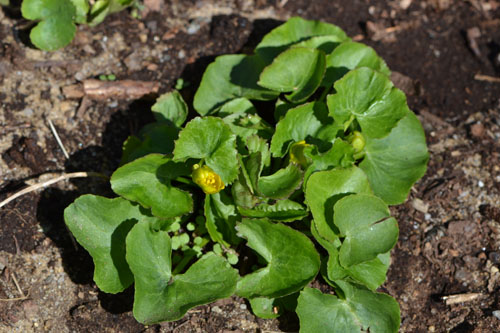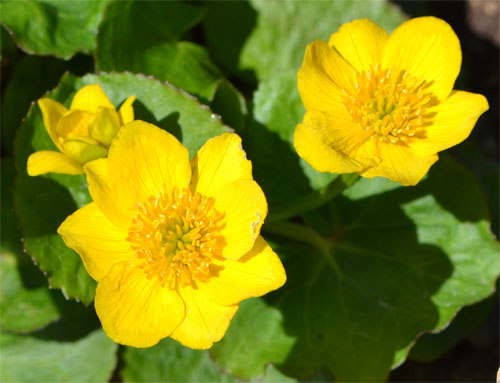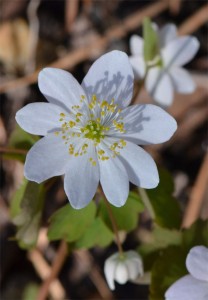There are several definitions floating around on what it means for a species to be invasive. A lot of laymen and scientists alike tend to use “invasive” as pertaining to the agressive nature or habit of a species of plant or animal where the new species negatively affects native species, by means of crowding it out; competing for nutrients, food, water, and light; or directly consuming or killing it. That is definitely one way of looking at this phenomenon. I personally don’t subscribe to this narrow viewpoint, because in nature this behavior is a rampant and every-day occurence. Just think of two competing ant hills, or a big pine denying light to saplings of other species or even its own kind. Are there, or were there ever, “safe” and balanced eco-systems? I don’t think so – competitive advantage and opportunistic tendencies are part of the DNA of anything alive today, and even that is sometimes not enough to safekeep a future for the next generation. Today, just like eons ago, the threat could come from a thousand miles away or from the brush or thicket right next to you. Have we, as humans, facilitated invasive behavior? Undoubtedly, our highways and parceling up of ever smaller tracts of land have led to situations where a handful of trees, rather than whole forests are competing with other species under changing environmental circumstances. Now, before I go off on a tangent (and it may already be too late for that) I want to point out that I use “invasive” as meaning “not originating from the eastern US or Canada”, and having arrived here by some kind of human intervention – whether it was last week or 400 years ago. The definition I use does not indicate agressiveness or anything else pejorative. It simply means that a plant or animal is originally native to Europe or Asia. It wasn’t here before, and now it is. Simple. As for the plants thenselves – a good amount of them are quite docile, happy to get along with other vegetation, and more often than not they (as Chris from Forest Keepers pointed out) have nutritional and medicinal value that should make it worth our while to get to know more about them, instead of reaching for the Roundup… I am actually fine with having dandelion and other assorted European and Eurasian species sprouting up. It’s futile to try to get rid of them, at best you’ll get temporary reprieve, and using chemical means just creates havoc downstream and over time in many unintended ways. Maybe the more obnoxious species such as asiatic bittersweet are more deserving of the “invasive” label, but again I am looking at plants from the point of origin, not from any behavioral approach.
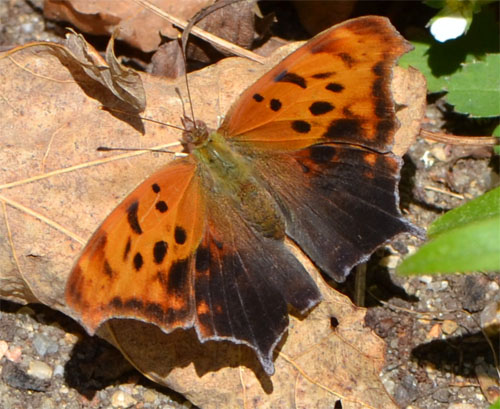
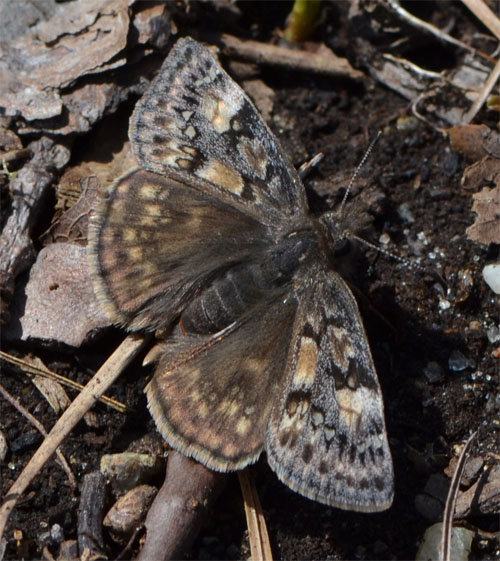 The more showy butterflies such as the monarch and swallowtail may still be “waiting in the wings”, as it were, but that does not mean that Papilionidae or true butterflies are not represented this time of year. The spring azure has been fluttering about for a few weeks now, and just the other day I noticed a juvenal’s duskywing (Erynnis juvenalis) in the yard, trying to blend in with the soil and mulch. This particular species of butterfly is quite common in Massachusetts (although I noticed it for the first time this week), and can be seen from April to early June in or near oak woods. Unlike other species this butterfly is generally single-brooded, meaning that there is only one generation each year. The larva are fully grown when they overwinter.
The more showy butterflies such as the monarch and swallowtail may still be “waiting in the wings”, as it were, but that does not mean that Papilionidae or true butterflies are not represented this time of year. The spring azure has been fluttering about for a few weeks now, and just the other day I noticed a juvenal’s duskywing (Erynnis juvenalis) in the yard, trying to blend in with the soil and mulch. This particular species of butterfly is quite common in Massachusetts (although I noticed it for the first time this week), and can be seen from April to early June in or near oak woods. Unlike other species this butterfly is generally single-brooded, meaning that there is only one generation each year. The larva are fully grown when they overwinter.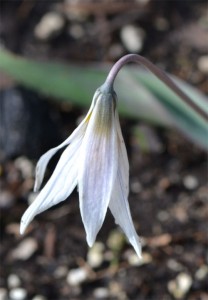 I was able to acquire a few pieces of rootstock of white trout lily last year, and put them willy-nilly in the garden without having too many expectations about the outcome. After all, immature plants produce a single leaf and fail to flower – so at best I was foreseeing a lot of dappled leaves for the next few years. Only mature plants bloom. I was happy to see plants emerge that had two leaves. In white trout lily speak this means that those plants will produce a flower. Even without a flower present, the leaves make an attractive ground cover. Plants multiply rapidly by root offshoots and seed, but you should always expect more single leaves than flowers…
I was able to acquire a few pieces of rootstock of white trout lily last year, and put them willy-nilly in the garden without having too many expectations about the outcome. After all, immature plants produce a single leaf and fail to flower – so at best I was foreseeing a lot of dappled leaves for the next few years. Only mature plants bloom. I was happy to see plants emerge that had two leaves. In white trout lily speak this means that those plants will produce a flower. Even without a flower present, the leaves make an attractive ground cover. Plants multiply rapidly by root offshoots and seed, but you should always expect more single leaves than flowers…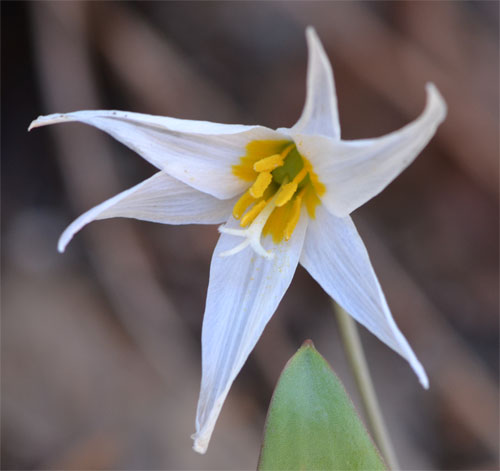
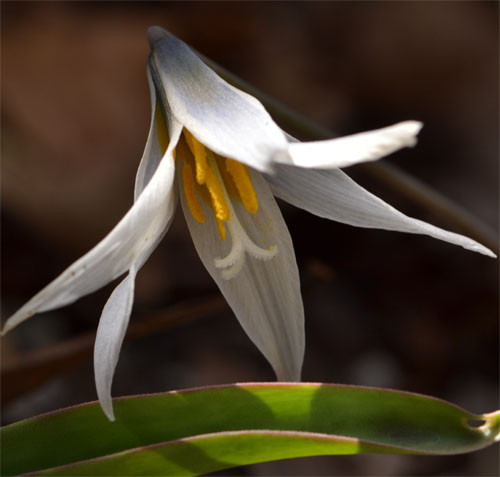
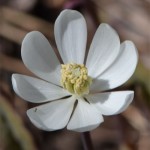 You may remember my post last year about the
You may remember my post last year about the 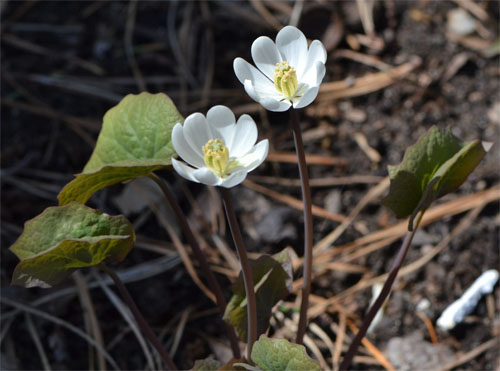
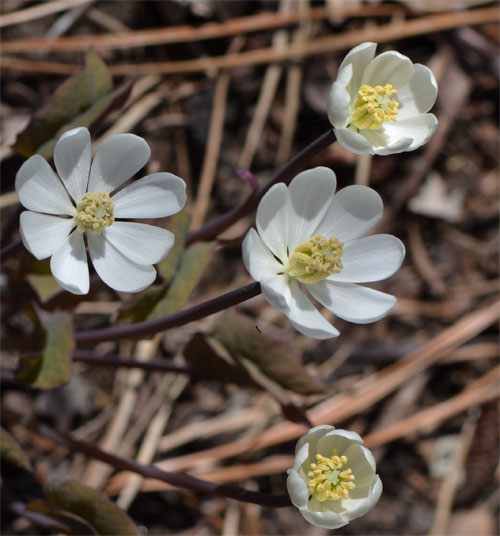
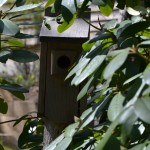 One story unit w/ open floor plan, lovingly maintained. Seeking clean and interesting tenants for seasonal occupancy. Property abuts woodland and wildflower garden. Two other units available still. Serious inquiries only. Open house 24/7…
One story unit w/ open floor plan, lovingly maintained. Seeking clean and interesting tenants for seasonal occupancy. Property abuts woodland and wildflower garden. Two other units available still. Serious inquiries only. Open house 24/7…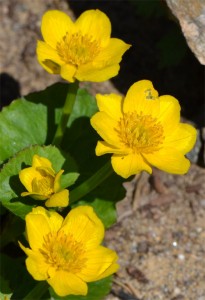 Marsh marigold (Caltha palustris) is a European and North American plant of the buttercup family. It is one of the most ancient native plants and I am frankly not quite sure whether it originated in Europe or in the Americas. It may have been growing here since before the last Ice Age and, after the retreat of the icecaps, it proliferated across the watery landscape.  It is still mostly found in wet places such as creek banks and low lying areas. I say “mostly” because I’ve seen it in uphill and dry areas as well. I have them in a location that is likely much drier than they would like, but they are exposed to the harsh sun only part of the day, and they seem to be thriving even though the plants I have are still relatively small – some road crew had done some work on an embankment and marsh marigolds had been dug up, displaced and thrown by the wayside. I am hoping these rejects will thrive in their new home. The leaves are round and glossy and the plant has large buttercuplike bright yellow flowers. The tops are reputed to be toxic but with boiling become edible and are often eaten as greens while young; the flower buds have been pickled and used as capers, and the flowers have been used for beverages. Some individuals may develop a rash or skin irritation from touching the plant – I found out the hard way that I am one of those people. Marsh marigolds bloom in early spring and are done blooming by late spring.Â
Marsh marigold (Caltha palustris) is a European and North American plant of the buttercup family. It is one of the most ancient native plants and I am frankly not quite sure whether it originated in Europe or in the Americas. It may have been growing here since before the last Ice Age and, after the retreat of the icecaps, it proliferated across the watery landscape.  It is still mostly found in wet places such as creek banks and low lying areas. I say “mostly” because I’ve seen it in uphill and dry areas as well. I have them in a location that is likely much drier than they would like, but they are exposed to the harsh sun only part of the day, and they seem to be thriving even though the plants I have are still relatively small – some road crew had done some work on an embankment and marsh marigolds had been dug up, displaced and thrown by the wayside. I am hoping these rejects will thrive in their new home. The leaves are round and glossy and the plant has large buttercuplike bright yellow flowers. The tops are reputed to be toxic but with boiling become edible and are often eaten as greens while young; the flower buds have been pickled and used as capers, and the flowers have been used for beverages. Some individuals may develop a rash or skin irritation from touching the plant – I found out the hard way that I am one of those people. Marsh marigolds bloom in early spring and are done blooming by late spring. 